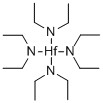
IdentificationPhysical DataSpectraRoute of Synthesis (ROS)Safety and HazardsOther Data
Identification
Product NameTETRAKIS(DIETHYLAMINO)HAFNIUMIUPAC Namediethylazanide;hafnium(4+) Molecular StructureCAS Registry Number 19824-55-6MDL NumberMFCD00799095SynonymsHafnium, tetrakis(diethylamino)-19824-55-6Tetrakis(diethylamino)hafniumdiethylazanide;hafnium(4+)Tetrakis(diethylamido)hafnium(IV)19962-12-0Ethanamine, N-ethyl-, hafnium(4+) salt (4:1)tetrakis-diethylaminohafniumSCHEMBL57242Tetrakis(diethylamino)hafnium(IV)MFCD00799095Tetrakis(diethylamino)hafnium 99.999%Tetrakis(diethylamido)hafnium(IV), 99.99%Molecular FormulaC16H40HfN4Molecular Weight467InChIInChI=1S/C5H6N2/c6-5-2-1-3-7-4-5/h1-4H,6H2InChI=1S/4C4H10N.Hf/c4*1-3-5-4-2;/h4*3-4H2,1-2H3;/q4*-1;+4 =1S/C5H6N2/c6-5-2-1-3-7-4-5/h1-4H,6H2InChI KeyVBCSQFQVDXIOJL-UHFFFAOYSA-N Isomeric SMILESCCCC.CCCC.CCCC.CCCC.
Physical Data
AppearanceYellow liquid
Spectra
No data available
Route of Synthesis (ROS)
Route of Synthesis (ROS) of TETRAKIS(DIETHYLAMINO)HAFNIUM CAS 19824-55-6
ConditionsYieldIn toluene at -79 - 20℃; for 4h; Inert atmosphere; Schlenk technique; Glovebox;76%
Safety and Hazards
Pictogram(s)SignalDangerGHS Hazard StatementsH225 (100%): Highly Flammable liquid and vapor H260 (33.85%): In contact with water releases flammable gases which may ignite spontaneously H261 (92.31%): In contact with water releases flammable gas H300 (33.85%): Fatal if swallowed H310 (33.85%): Fatal in contact with skin H314 (40%): Causes severe skin burns and eye damage H315 (60%): Causes skin irritation H319 (60%): Causes serious eye irritation H330 (33.85%): Fatal if inhaled H335 (100%): May cause respiratory irritation Precautionary Statement CodesP210, P223, P231+P232, P233, P240, P241, P242, P243, P260, P261, P262, P264, P264+P265, P270, P271, P280, P284, P301+P316, P301+P330+P331, P302+P335+P334, P302+P352, P302+P361+P354, P303+P361+P353, P304+P340, P305+P351+P338, P305+P354+P338, P316, P319, P320, P321, P330, P332+P317, P337+P317, P361+P364, P362+P364, P363, P370+P378, P402+P404, P403+P233, P403+P235, P405, and P501(The corresponding statement to each P-code can be found at the GHS Classification page.)
Other Data
No data available
DruglikenessLipinski rules componentMolecular Weight471.042HBA4HBD0Matching Lipinski Rules3Veber rules componentPolar Surface Area (PSA)12.96Rotatable Bond (RotB)12Matching Veber Rules1
Use PatternTETRAKIS(DIETHYLAMINO)HAFNIUM CAS 19824-55-6 are frequently used in thin film deposition, particularly in the semiconductor manufacturing industry. They serve as precursor materials for thin film preparation, for example, in the fabrication processes of integrated circuits and other electronic devices.
https://www.chemwhat.com/tetrakisdiethylaminohafnium-cas-19824-55-6/
Comments
Post a Comment